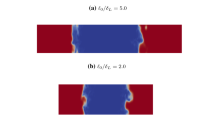Abstract
A simplified and improved correlation for the drag coefficient of windblown natural gas flames is given. Experimental results leading to the correlation were obtained in a low-speed wind tunnel specifically designed for such studies at the University of Oklahoma North Campus.
Similar content being viewed by others
References
“The Effect of Wind on Buoyant Diffusion Flames”, O. A. Pipkin and C. M. Sliepcevich,I & EC Fundamentals, Vol. 3 (May 1964), pp. 147–154.
“Study of Inclination of Flame Due to Wind,” M. Hamada,Bulletin of Fire Protection Society of Japan, Vol. 1, No. 2 (1952), pp. 41–43.
“A Low Speed Wind Tunnel for Measuring the Effect of Wind on Buoyant Diffusion Flames,” J. R. Welker and C. M. Sliepcevich,OURI Technical Report No. 1, NBS Contract 1142, University of Oklahoma (25 September 1964).
“The Design and Calibration of a Very Low Speed open Circuit Wind Tunnel,” R. A. Milburn (M.S. Thesis, School of Aerospace and Mechanical Engineering, University of Oklahoma, 1965).
Author information
Authors and Affiliations
Rights and permissions
About this article
Cite this article
Welker, J.R., Pipkin, O.A. & Sliepcevich, C.M. The effect of wind on flames. Fire Technol 1, 122–129 (1965). https://doi.org/10.1007/BF02588482
Issue Date:
DOI: https://doi.org/10.1007/BF02588482



